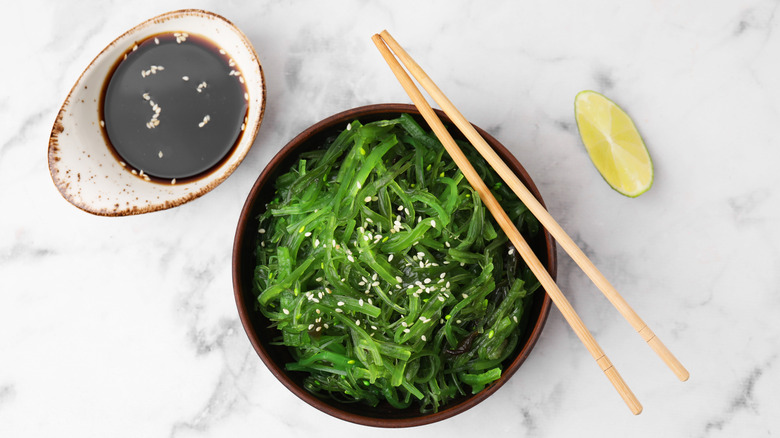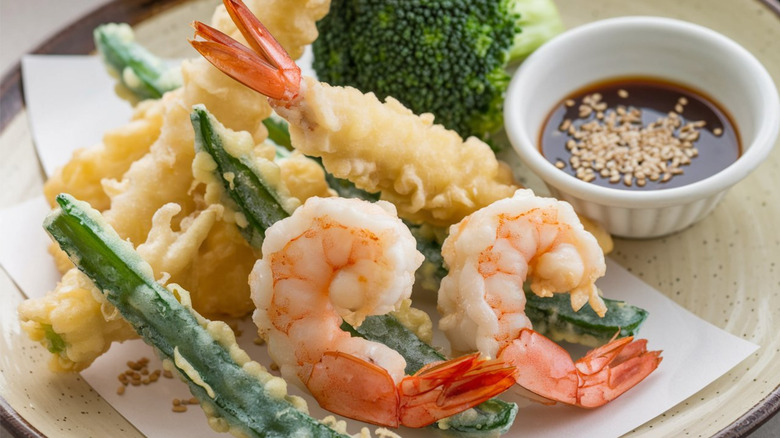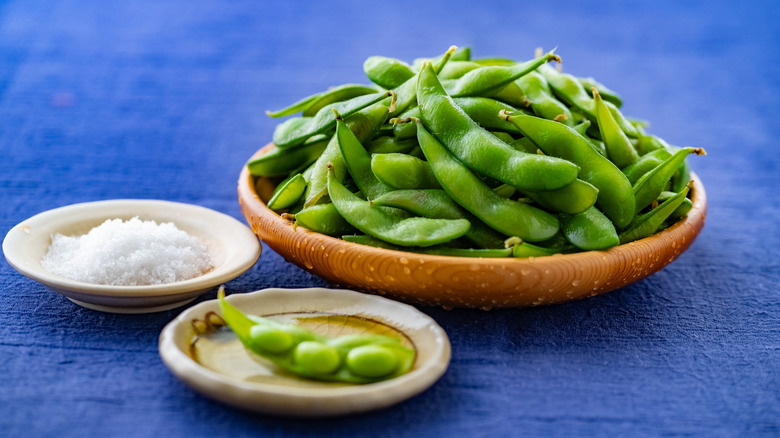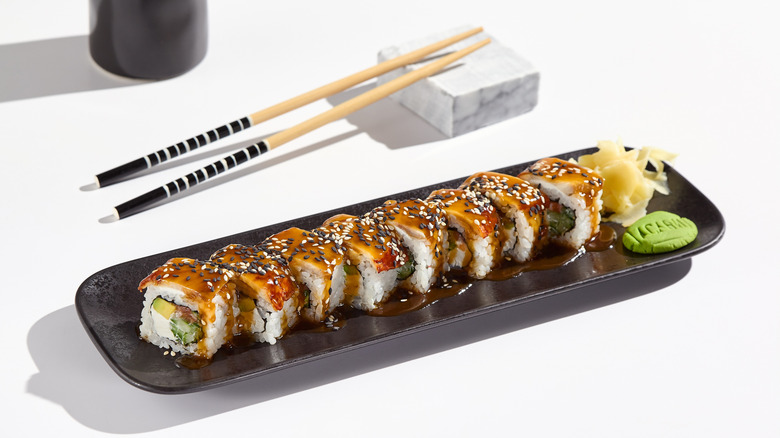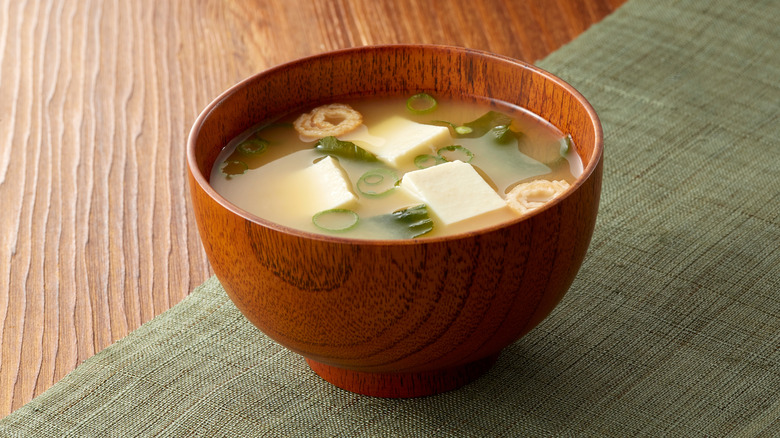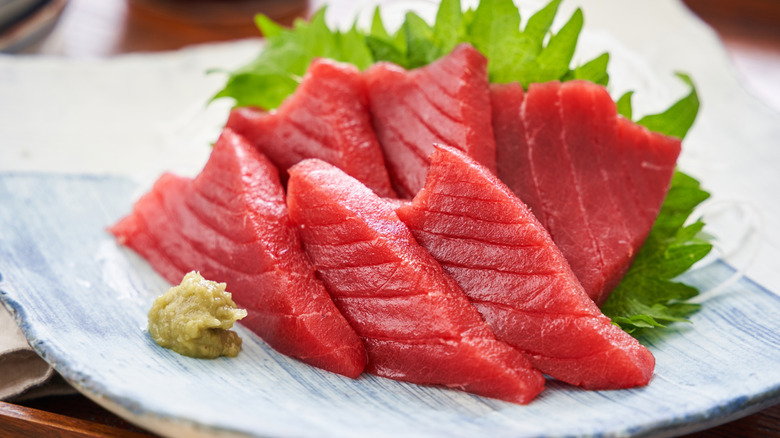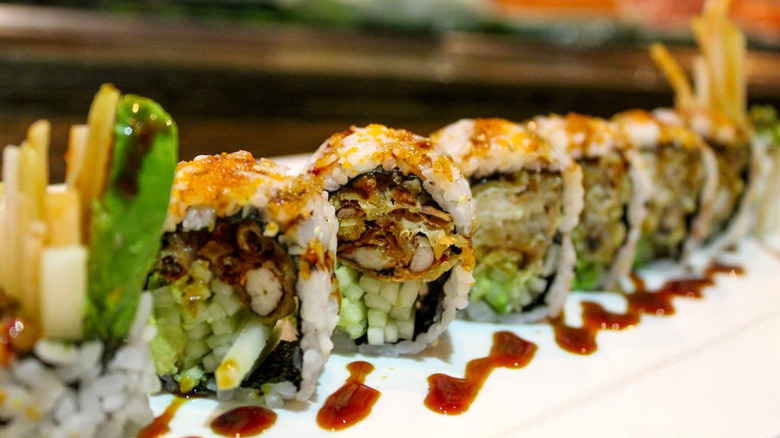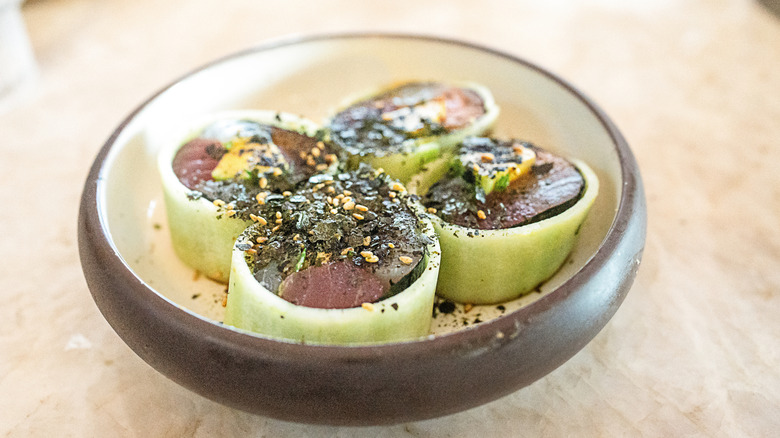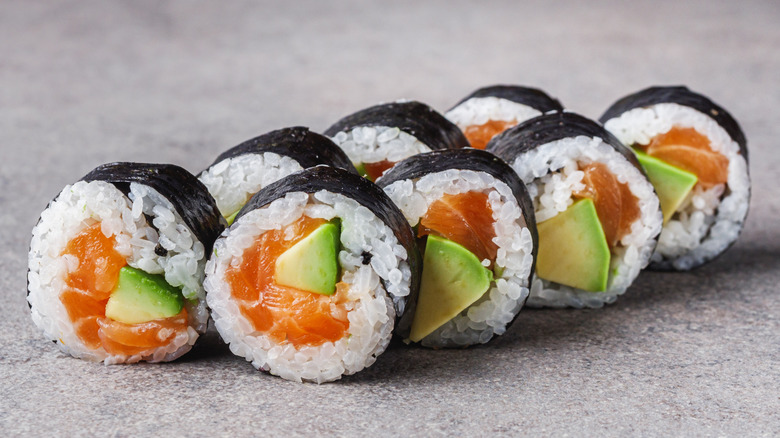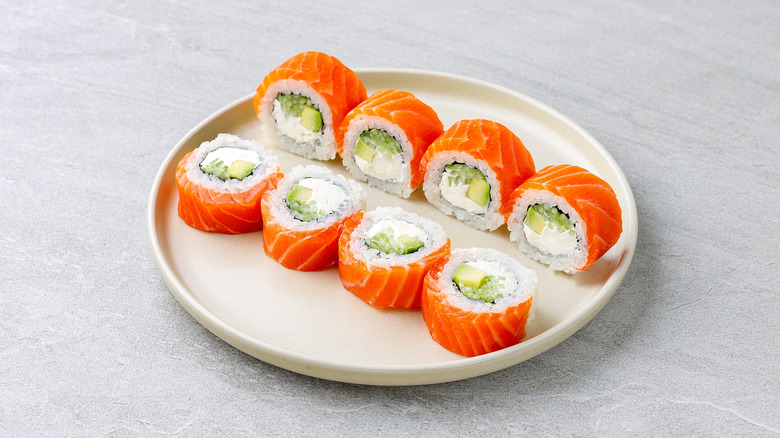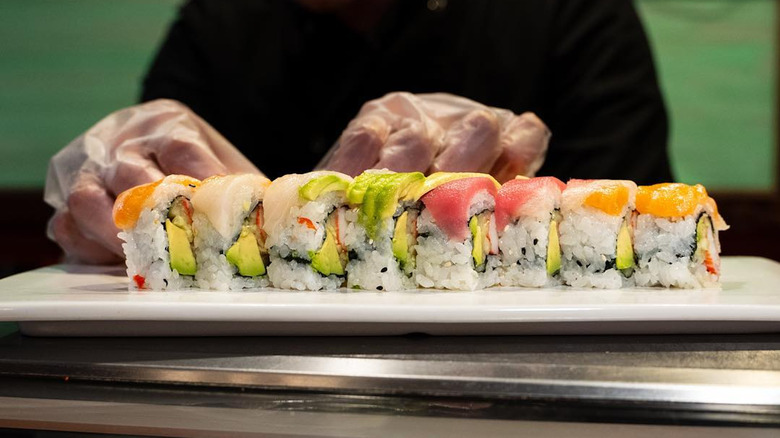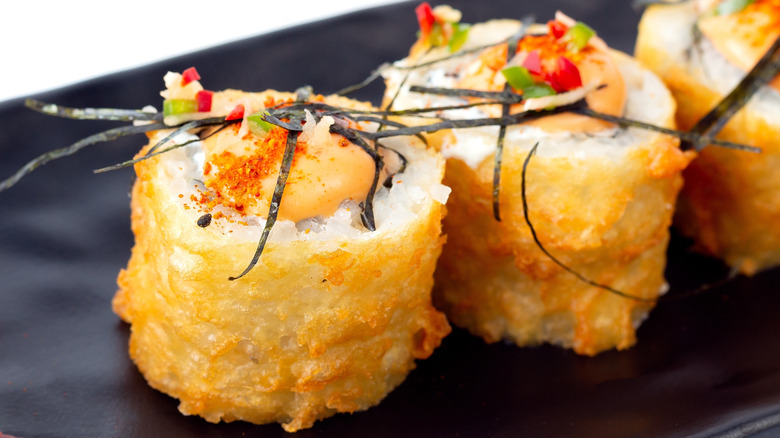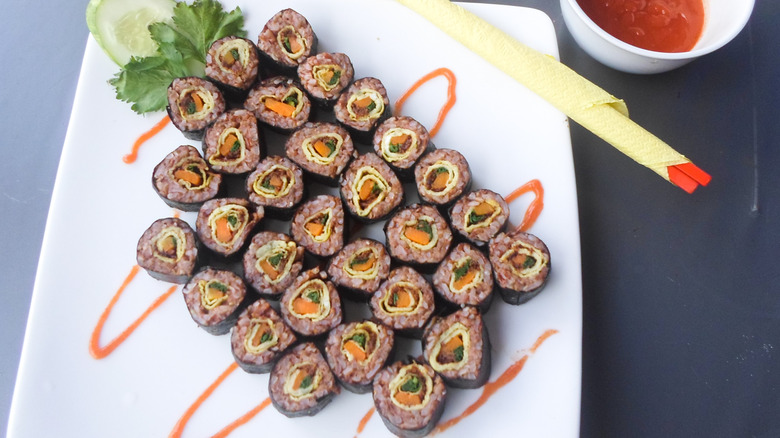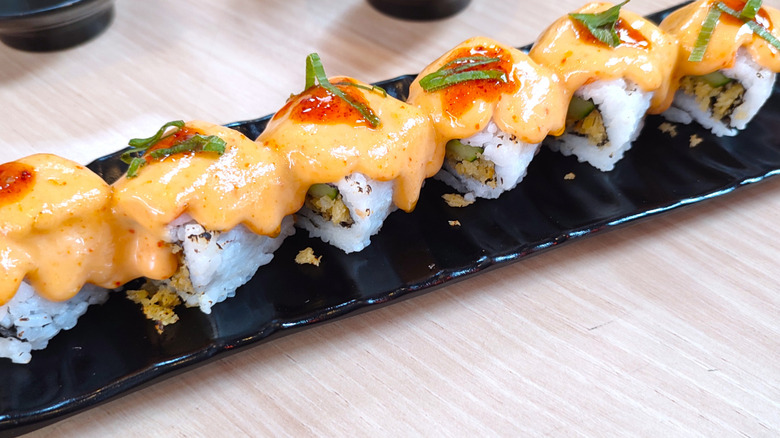8 Unhealthiest And 8 Healthiest Things To Order At A Sushi Restaurant
Craving sushi but trying to eat healthy? We've got good news! There are plenty of nutritious options at sushi restaurants. You just have to know what to order and what to avoid.
Before diving in, let's define what "healthy" actually means. The term is surprisingly subjective and ultimately depends on your personal goals. Your gym-loving friend may prioritize protein, while your vegan buddy focuses on simple, plant-based foods. But there are certain universal truths we can all agree on — fresh, real ingredients beat processed junk, variety keeps your body happy, and balance is key. Looking at the standard American diet, most of us are drowning in excess calories, which are skewed toward carbs, sugar, and sodium, while running low on omega-3s, quality protein, and essential vitamins.
With these nutritional concerns in mind, we've analyzed popular sushi restaurant items and created the ultimate dining cheat sheet. Below, you'll find eight of the healthiest and eight of the unhealthiest foods to order at sushi restaurants. We'll break down what makes each item worth embracing or avoiding, so you can make informed choices that align with your health goals!
Healthiest: Goma wakame
Goma wakame, also known as seaweed salad, is made from wakame seaweed mixed in a sesame and rice wine vinegar dressing. Recipes and portion sizes vary by restaurant, but a ½-cup serving typically has 110 calories, with 4 grams of fat, 1 gram of protein, and 17 carbs, including 6 grams of fiber. However, where this dish truly shines is its vitamin and mineral content. It's one of the best sources of natural iodine, an essential mineral that supports thyroid hormone production. It's also rich in magnesium and calcium, which are crucial to bone health and muscle formation.
Goma wakame is known for its umami-rich, slightly briny flavor. It's become increasingly popular in the past decade, partly because seaweed itself was one of the biggest food trends a few years ago. It could also be that this culinary delight isn't commonplace — it feels unique to Japanese restaurants, and since we don't often make this dish at home, it gives us the perfect excuse to order it when dining out. If you're prioritizing nutrient-dense foods, you're in the clear, so start your meal with a healthy seaweed salad.
Unhealthiest: Tempura
Tempura is one of the most tempting items on a sushi menu. Crispy battered shrimp or veggies served alongside a sweet, umami-rich dipping sauce? We'd normally say "yes, please!" But if your goal is to eat healthy, we'd reconsider this order. A restaurant serving of vegetable tempura can have more than 1,500 calories with over 100 grams of fat. Plus, you're getting far more refined flour than you may imagine. If it's the veggies you're after, go for a simple avocado salad instead, or order sashimi if you're aiming for protein.
When consuming deep-fried food, you're also exposed to AGEs (advanced glycation end products) — harmful molecules that form when food hits high temperatures. This acronym has a bit of a double meaning here, because these sneaky compounds also accelerate aging and contribute to inflammation and chronic disease. So while skipping that golden, crunchy tempura might be difficult, your future self will thank you.
Healthiest: Edamame
There's something super satisfying about snacking on a bowl of edamame. It provides the perfect tide-me-over until those sushi rolls arrive, and thankfully, you can enjoy it freely because it's one of the healthiest things you can order at a sushi joint. One cup of edamame has 188 calories with 19 grams of protein and 8 grams of fiber. Mind you, you'd be hard-pressed to eat a full cup, since this starter is often shared among the table, and munching on these bean-filled pods requires a little labor, slowing down the eating process.
Edamame is one of the only complete sources of plant-based protein, meaning it has all nine essential amino acids your body can't make independently. Aside from protein, edamame is packed with isoflavones, plant compounds that promote healthy cellular growth and protect against disease. These legumes also boast omega-3s, which support heart health. Finally, starting your meal with fiber helps stabilize blood sugar and sets your digestive system up for success.
Unhealthiest: Anything with teriyaki or eel sauce
Sauces can make or break a meal — both in terms of flavor and health. You might be ordering chicken or seafood, thinking you're on the right path. But if it's drizzled in a heavy sugar-laden sauce, you're doing more harm than good. Unfortunately, that's exactly what you get with teriyaki and eel sauces.
A tablespoon of teriyaki has 16 calories, nearly 3 grams of sugar, and 30% of the daily recommended value of sodium. Meanwhile, a tablespoon of eel sauce has 32 calories, 6 grams of sugar, and 15% of your daily recommended sodium. While this doesn't seem like a ton, these numbers add up quickly, especially with particularly saucy items. Plus, this sugar and salt combo is a double whammy in the blood pressure department. In a 2019 study published in "Hypertension," sugar and salt were shown to have a synergistic effect on elevating blood pressure — something to consider if you already suffer from hypertension.
Which sushi menu items include these sauces? Anything with teriyaki in the title, like teriyaki-glazed chicken or teriyaki donburi, is a dead giveaway. Sushi bowls may be a more unexpected culprit. Meanwhile, sushi rolls and nigiri with eel are often drizzled with eel sauce. If you're ordering one eel nigiri, it won't do much harm. But if you're ordering loads of items drenched in sauces, you may want to reconsider, especially since this is already one of the sushi restaurant red flags to watch out for.
Healthiest: Miso soup
Miso soup is an excellent starter at sushi restaurants, not just for its umami flavor but also for its wealth of health benefits. Miso is made from fermented soybean paste mixed with broth, tofu, seaweed, and other goodies. The fermented paste is rich with enzymes, prebiotics, and probiotics that all support gut health. The soup is also an excellent source of vitamin K, manganese, copper, zinc, and calcium.
If you're avoiding gluten for health reasons, there's a way to tell if your miso soup is gluten-free. Ask which type of miso paste is used and ensure any added ingredients don't contain gluten, like that pesky soy sauce. Restaurant staff may immediately know if the miso is gluten-free, but just so you're aware, rice, chickpea, and corn-based miso pastes are safe.
Miso soup has a relatively balanced macronutrient profile, with 1 cup containing 59 calories, 3 grams of fat, 4 grams of carbs, and 6 grams of protein. Mind you, it can have a hefty amount of sodium — a common issue across sushi condiments and cuisine. However, we feel the advantages far outweigh the drawbacks. So if you're ordering this starter, enjoy miso soup the proper way by lifting the bowl to your mouth to savor the flavor and all those health benefits.
Unhealthiest: Fish high in mercury
Fish is usually a healthy source of protein and fat — unless it comes with an unwelcome side of mercury, in which case, that sashimi could do more harm than good. The biggest culprits include shark, swordfish, and bluefin tuna. Some bluefin tuna have even tested mercury levels at two and a half times higher than FDA safety limits, which is like paying a premium for a premium problem.
Fish absorb mercury from polluted water, and when you consume the fish, you absorb that mercury too. It's basically a toxic game of telephone where nobody wins. High mercury levels can mess with your nervous system and cardiovascular health, potentially affecting fine motor skills, memory, and focus. While the occasional piece won't hurt, frequent exposure (especially if you're pregnant or planning to be) poses a greater risk. So if you're trying to eat healthy at a sushi restaurant, check out our list of fish with the highest and lowest levels of mercury.
Healthiest: Sashimi
The difference between sushi and sashimi is that sashimi is pure, unadulterated raw fish, while sushi always includes vinegared rice. Sashimi consists primarily of protein and healthy fats, providing the perfect counterpoint to our carb-heavy American diet. Plus, if the ingredient list is just fish, there's little chance of sneaky additives or preservatives hijacking your meal.
With sashimi, you've got plenty of options, from buttery salmon and yellowtail to seabream and squid. A popular choice is sashimi made from thinly sliced raw salmon, which is traditionally called sake (not to be confused with the Japanese rice wine). If eating plain raw fish solo isn't your jam, try nigiri instead. It consists of a small serving of rice topped with raw seafood. But whatever you order, remember our earlier mercury warning to steer clear of any potentially dangerous fish — go easy on the tuna if you're making sashimi a regular meal.
Unhealthiest: Spider roll
When you visit a sushi restaurant, you definitely want to order some rolls. They're fun, shareable, and give you the full sushi experience. So while our list has primarily focused on starters and simple ingredients until now, we're about to dive into sushi roll territory, starting with one to avoid: the spider roll.
Spider rolls are made with tempura-fried soft-shell crab, nori, seaweed, sushi rice, and other fillings, such as cucumber, avocado, asparagus, and eel sauce or spicy mayonnaise. The health issue here is largely due to the roll's preparation method. The tempura batter used for the crab adds empty calories and soaks up oil like a sponge, while the mayo or eel sauce contributes another layer of relatively empty calories.
Nutrition info depends on the restaurant's recipe, but generally speaking, one spider roll can pack a hefty 510 calories, with 68 grams of carbs and 21 grams of fat. To put it in perspective, this calorie content rivals that of a Big Mac, disguised as healthy food. So while it may be wrapped in seaweed, spider rolls don't contain the pure, simple ingredients you expect from authentic Japanese cuisine.
Healthiest: Naruto rolls
Naruto rolls may be the most nutrient-dense sushi rolls available. While white rice isn't devoid of nutrients, many would consider it empty calories. Fortunately, Naruto rolls swap the rice for a thin, long sliver of fresh cucumber. So if you're trying to maximize your caloric intake, you can still enjoy those sushi rolls, assuming your local sushi joint offers Naruto-style rolls.
One cup of cucumber contains just 16 calories, considering it's 95% water. It also provides a small amount of vitamins A, C, and K. Mind you, the amount of cucumber in one Naruto roll is almost negligible calorie-wise. However, it makes these roles incredibly refreshing and perfect for when you want something that tastes light. Plus, you get all the fun of eating sushi rolls without the carb crash that follows. Your stomach stays satisfied, your energy stays stable, and you avoid the sluggish aftermath of a heavy sushi meal.
Unhealthiest: Dragon roll
Dragon rolls look like beautifully crafted culinary masterpieces with their carefully sliced unagi and deliberately drizzled eel sauce, but don't let the presentation fool you. Underneath all that artistry is a whopping 569 calories per roll, with 26 grams of fat and 46 grams of carbohydrates. With that macronutrient profile, one sizable roll could be a standalone meal ... but who eats just one roll at a sushi restaurant?
Calories aside, consuming eel also presents an ethical issue. Many eel species used in sushi are actually endangered, yet still regularly end up on plates. USA Today reports that according to a study, 44% of eels in North America come from critically endangered European eels. While the export of this species has been illegal since 2010, organized crime has contributed to its importation and distribution. So if you're deciding between sushi rolls, save your conscience and calories for a healthier, more ethical choice.
Healthiest: Salmon and avocado rolls
When it comes to healthy sushi rolls, salmon and avocado make a dynamic duo. Whether you choose salmon avocado maki or inside-out rolls, these menu items keep things simple. You get quality fish, creamy avocado, rice, and seaweed. No tempura, no mayo, and no mystery sauces. Of course, you'll likely dip it into a little sauce for added flavor — just don't go crazy. We encourage you to stop drowning your sushi in soy sauce since it detracts from the fresh flavors of the roll. Instead, a simple dip (fish side down) should add just enough umami goodness without overpowering the fish.
Salmon and avocado are packed with nutritional benefits. Salmon has omega-3 fatty acids that support heart health, while avocado provides healthy monounsaturated fats and fiber. Together, they create a beautiful balance of taste, texture, and essential nutrients. The combination is satisfying enough to keep you full without leaving you in a food coma. And since healthy fats and proteins are oh-so satiating, you're less likely to overeat at that sushi buffet.
Unhealthiest: Philadelphia roll
Cream cheese is already a controversial ingredient in sushi rolls, with many people claiming that it doesn't belong in sushi at all. However, the famous Philadelphia roll is a staple in most American sushi joints and is loved by many. Unfortunately, health-conscious diners should know that while Philadelphia rolls sound light and healthy, the cream cheese filling packs a hefty amount of calories compared to other sushi ingredients.
Two tablespoons of cream cheese have 100 calories and 10 grams of fat, 6 of which come from saturated fat. We're not here to villainize saturated fat — it's healthy in the right amount and needed for hormone production and cellular health. But many people get more saturated fat than they need, which can raise HDL cholesterol levels, throwing off the delicate balance between LDL and HDL in their blood. So if you're craving a satisfyingly fatty sushi roll but struggle with cholesterol issues, opt for a salmon and avocado one instead.
Healthiest: Rainbow rolls
The saying "eat the rainbow" generally applies to fruits and veggies, but the concept can be applied to all food groups. When you eat a wide variety of colorful, natural foods — including seafood — you're more likely to get all the vitamins and minerals your body needs to thrive. And when it comes to sushi, rainbow rolls offer this nutritional diversity.
Rainbow rolls get their name from the colorful toppings, which include tuna, salmon, shrimp, yellowtail, and avocado. This combination creates a vibrant, visually appealing roll, and allows the diner to sample multiple fish with one order, benefiting from an array of nutrients. Shrimp boasts astaxanthin, a powerful antioxidant, while salmon is packed with B vitamins, and yellowtail has a healthy dose of selenium. And though rainbow rolls are relatively high in calories, they pack a decent amount of protein too. One roll has 475 calories, 50 grams of carbs, 16 grams of fat, and 33 grams of protein.
Unhealthiest: Fried rolls
Fried sushi rolls are just as they sound. You get a standard sushi roll, dunk the entire thing in tempura batter, and toss it into a fryer. These rolls might be called fried maki or tempura rolls on the menu, or they may have specialty names, depending on the restaurant. Truthfully, most any type of roll can be battered and fried to create a crispy texture. But while deep-fried sushi rolls are absolutely delicious, they have the same negative health consequences as regular tempura.
Nobody thinks to themselves, "I'm going to eat healthy today. Let's start by dipping batter into piping hot oil." Making matters worse, many restaurants use processed vegetable or seed oils, which can form trans fats when heated. These types of trans fats can be hard to digest and contribute to health conditions like heart disease and obesity. So if you're craving sushi rolls, stick to standard maki or inside-out options, and if you want an exciting texture, pick one with tobiko — those tiny, salty fish eggs that pop in your mouth.
Healthiest: Brown rice rolls
It's nearly impossible to avoid rice at a sushi restaurant — and why would you want to? Sushi is derived from the Japanese words for "sour rice," and this dish is an integral part of the sushi experience. However, if you're eating several rolls and trying to be healthy, consider switching one up for a brown rice roll instead.
Brown rice trumps white rice in the health department because it has undergone less processing. It retains the germ layer, which is rich in fiber and nutrients. This means brown rice rolls keep you fuller longer and won't spike your blood sugar quite as much. It also boasts more magnesium, potassium, iron, and B vitamins than white rice. It's basically the multivitamin version of white rice! Of course, when it comes to flavor, brown rice won't have that classic sour taste you get from sushi rice, but it still adds an unexpected yet pleasant complexity.
Unhealthiest: Rolls loaded with mayo-based sauces
If you see "spicy" on a sushi menu, there's a good chance you're about to eat a mayo-laden roll. Popular rolls like volcano rolls, spicy tuna rolls, and shrimp mayo hand rolls are typically loaded with massive amounts of mayo-based sauces. Mayonnaise is one of the most calorically dense condiments out there, with a 1-tablespoon serving packing a whopping 94 calories, all from fat. And while fat itself isn't inherently bad for you, consuming too much mayo could mean you're getting more than you truly need. Plus, mayonnaise has a way of sneaking into dishes, meaning you may end up consuming hefty amounts of this condiment without even realizing it.
Health aside, too much mayo drowns out that fresh fish flavor you're actually paying for. Instead of those bright, delicate flavors of tuna or sweet crab, you're mostly tasting processed oil. If you're heading to a sushi restaurant, skip the mayo-heavy rolls and prioritize healthier options, like rainbow rolls, cucumber avocado rolls, or salmon nigiri.

